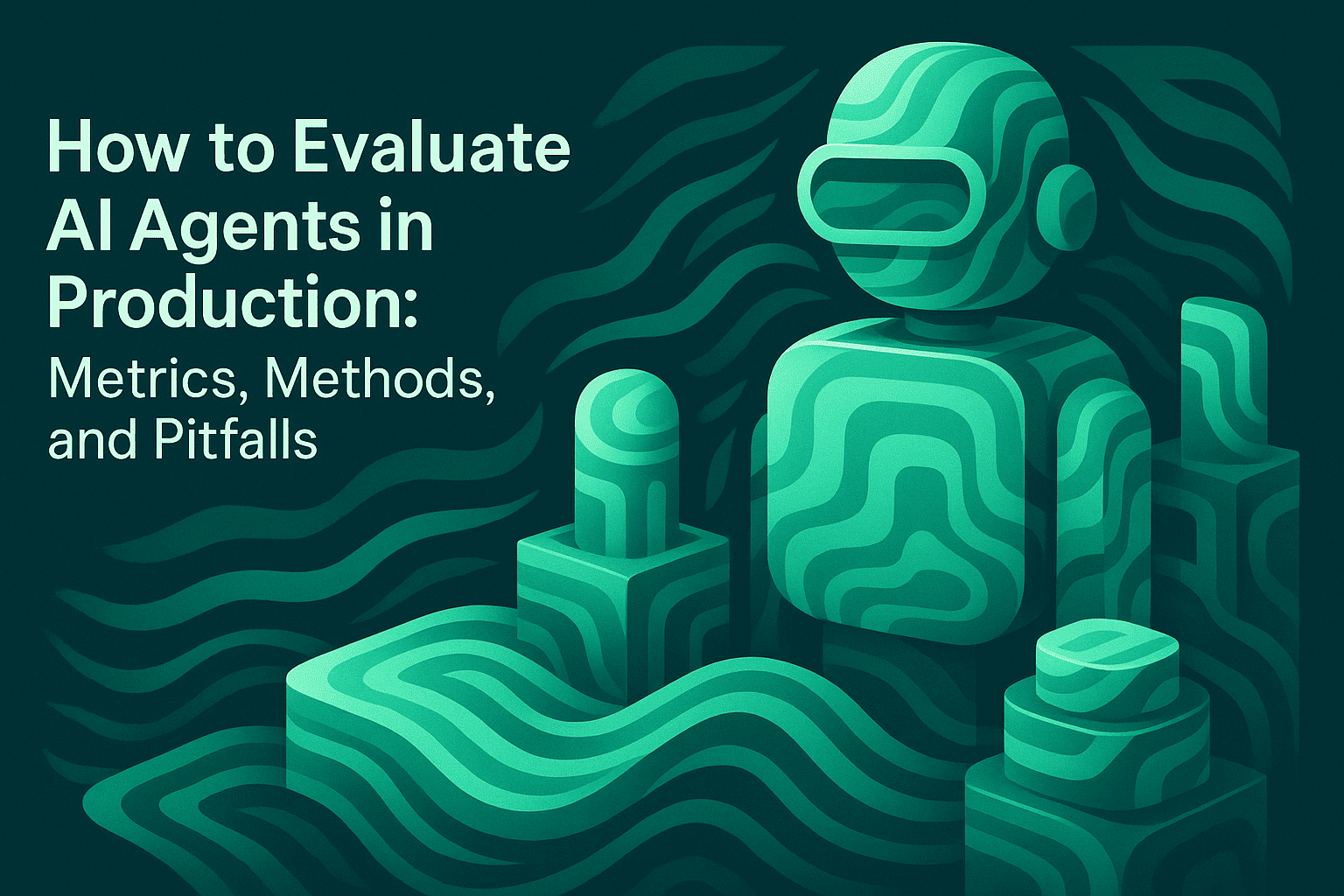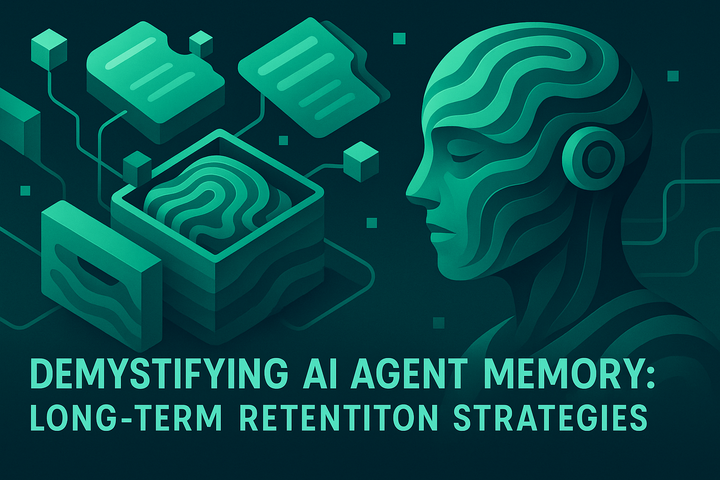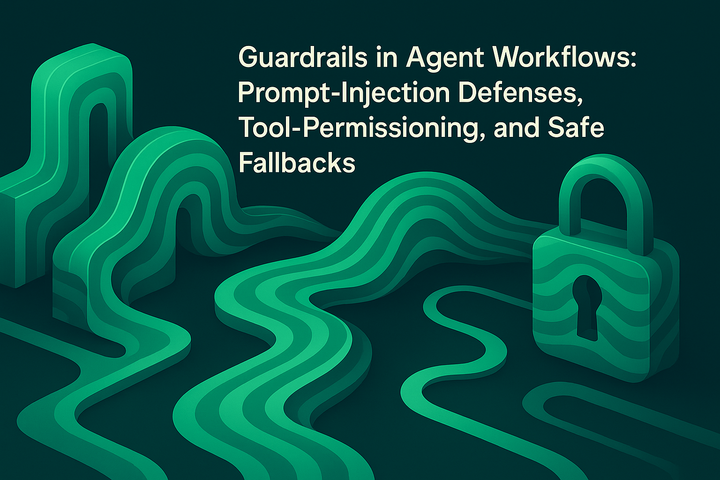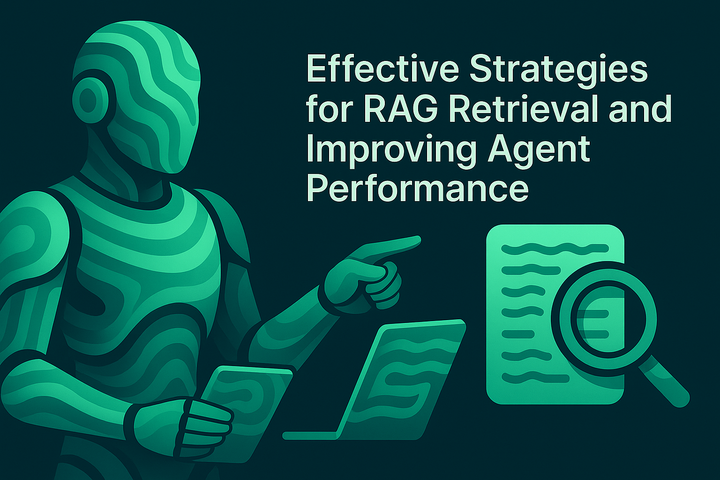How to Evaluate AI Agents in Production: Metrics, Methods, and Pitfalls

TL;DR:
AI agents in production now orchestrate complex workflows that traditional model benchmarks weren't designed to evaluate. These agents operate across multiple steps, depend on external tools, and must maintain context throughout conversations. This guide shares a practical framework for evaluating agent reliability at every level, with lessons from real-world teams using Maxim to simulate, monitor, and improve agents in production.
Introduction
AI agents in production require different evaluation approaches than the language models they're built on. While a language model might excel on static benchmarks, an agent making real-time decisions across multi-step workflows faces challenges that traditional evaluation frameworks weren't designed to capture.
Agent failures in production rarely manifest as crashes or 500 errors. Instead, they appear as subtle trajectory deviations: a customer support agent looping through the same clarifying questions, a research agent selecting the wrong tools, or a booking agent silently abandoning tasks mid-execution. These quality degradations slip past conventional monitoring until they've already impacted user trust.
This guide shares what we've learned about adapting evaluation strategies to match the complexity of agentic systems, drawing from our platform experience, emerging industry research, and lessons from production deployments across diverse use cases.
Why Agent Evaluation Diverges From Model Evaluation
Traditional model evaluation treats AI as a stateless function: given input X, does the model produce acceptable output Y? This paradigm breaks down when systems maintain conversation history, orchestrate multiple tool calls, and adapt their behavior based on environmental feedback.
Three fundamental shifts distinguish agent evaluation from model evaluation:
State Management Across Turns
Quality no longer depends just on individual responses. It hinges on how well the system tracks user intent, tool results, and conversation state over time. A single incorrect context update can cascade into compounding errors across multiple turns.
In Maxim’s observability platform, we see this constantly. An agent might correctly answer a user's first question, but then lose critical context from that exchange, causing it to repeat work or contradict itself three turns later. Session-level tracing in Maxim helps preserve the complete conversation context and make these failures visible.
Decision Chains With External Dependencies
Agents make sequential decisions that rely on external tool execution, API responses, and retrieval results. A single failed API call or poorly-constructed query can derail the entire workflow.
Evaluation must account for tool selection accuracy (did it pick the right tool?), parameter construction (were the inputs correct?), error recovery (did it handle failures gracefully?), and whether the agent knows when to retry versus when to escalate to a human.
Trajectory Fidelity Over Output Correctness
Static benchmarks ask, "Is this response accurate?" Production agent evaluation asks, "Did the system take the right path to achieve the user's goal?" An agent might generate perfectly coherent text while executing a fundamentally flawed plan: searching when it should calculate, or making multiple redundant API calls when one would suffice.
Our simulation platform helps teams test complete agent trajectories across realistic scenarios, catching these planning failures before they reach production. Research from Stanford's Center for Research on Foundation Models validates this approach. Their work shows traditional benchmarks often fail to predict real-world agent reliability, especially when tool orchestration is required.
Our Framework: Layered Evaluation for Production Agents
Based on our experience helping teams ship reliable agents, Maxim has developed a three-layer evaluation framework. Each layer captures different dimensions of quality and serves different debugging purposes.
Layer 1: System Efficiency Metrics
Before assessing whether an agent accomplishes its goals correctly, you need baseline visibility into operational behavior. Maxim automatically tracks:
Completion time measures task and sub-step duration, surfacing bottlenecks that degrade user experience. In our dashboard, teams often discover that a single slow retrieval operation blocks the entire workflow, something that's invisible when you only look at end-to-end latency.
Token consumption tracks computational costs across planning, tool invocation, and response generation. We've seen agents burn through API quotas with redundant reasoning loops.
The tool call volume quantifies the number of external operations the agent invokes. High counts often indicate poor planning: agents that search, summarize, then search again for the same information are wasting both latency and money.
Layer 2: Session-Level Success Metrics
Session-level evaluation measures whether the agent achieved the user's intended outcome across the complete interaction. Maxim evaluators operate at this granularity because it matches how users actually experience your agent.
Task success determines if the agent accomplished its goal. For a travel booking agent, success means completing a reservation that matches the user's dates, budget, and preferences. In Maxim, teams define custom success criteria specific to their domain. These run automatically on every session.
Step completion assesses whether the agent followed expected workflows. If your checkout flow should authenticate, validate payment, and then confirm order, but validation gets skipped, our trace visualization highlights the deviation immediately.
Trajectory quality evaluates the path taken, not just the destination. Our analysis tools identify agents stuck in loops, making redundant calls, or exploring unnecessary branches. Even when they eventually arrive at the right answer, inefficient trajectories waste resources and frustrate users.
Self-aware failure handling tracks how agents communicate their limitations. Research from Anthropic on Constitutional AI emphasizes that explicitly acknowledging uncertainty is often safer than generating plausible-sounding but incorrect responses. We've built evaluators that reward this appropriate uncertainty.
Layer 3: Node-Level Precision
Node-level evaluation inspects individual operations within agent workflows, isolating exactly where quality degrades. This is where Maxim's distributed tracing really shines. Every tool call, retrieval, and generation step becomes a traced span you can evaluate independently.
Tool call validity ensures agents construct tool calls correctly with proper arguments, schema adherence, and required fields. We've seen agents invoke database queries when they should use web search, or pass malformed parameters that cause downstream failures. Our node-level evaluators catch these issues before they compound.
Tool call error rates track execution failures: timeouts, authentication errors, and network issues. Our alerting system flags sudden spikes so teams can respond before users are impacted.
Reasoning step utility measures whether each planning or reasoning step contributes to progress. Poor plans with dead ends or redundant steps lead to wasted effort, even if individual steps execute correctly. Our simulation platform lets teams test reasoning quality across hundreds of scenarios before deployment
The OpenTelemetry project provides distributed tracing standards that we've adopted and extended for agent-specific observability.
Evaluation Methodologies: Blending Automation and Human Review
Production agent evaluation requires multiple assessment approaches working together. In Maxim, we've built infrastructure that makes it straightforward to combine:
Deterministic rules catch structural violations quickly: malformed JSON, missing required fields, policy breaches. Our evaluator library includes pre-built checks for common patterns, and you can add custom rules specific to your domain. These are fast, consistent, and provide immediate feedback.
Statistical monitors track distributions of metrics like response length, reasoning steps, and token usage over time. Our dashboards visualize these distributions and alert you when sudden shifts indicate quality degradation. This catches drift that deterministic rules miss.
LLM-as-a-judge evaluators assess subjective qualities like helpfulness, coherence, and appropriate tone. While research highlights challenges with judge reliability in specialized domains, our implementation includes chain-of-thought reasoning and structured rubrics that improve consistency. The key insight: LLM judges work best when combined with human validation.
Human review loops provide ground truth for critical decisions. In our platform, you can route specific sessions to expert reviewers based on criteria you define: low evaluator scores, high-stakes interactions, or random sampling for calibration. Teams typically route a subset of interactions to human review to validate their automated evaluators.
Instrumentation: How We Capture What Matters
Effective evaluation depends on comprehensive instrumentation. Here's how we approach it:
Distributed tracing tracks execution flow through multi-step workflows. Following OpenTelemetry standards, we create hierarchical traces where parent spans represent complete sessions and child spans represent individual operations. This enables root cause analysis. You can see exactly which tool call failed or which retrieval returned irrelevant context.
Session-level logging preserves the complete conversation context. Our platform automatically captures user messages, agent responses, internal reasoning, and tool results. This granularity lets you reproduce specific issues by replaying exact interaction sequences, which is critical for debugging complex multi-turn failures.
Custom attributes enrich traces with business context. Teams often add metadata like user segments, feature flags, or A/B test variants. This enables slicing production data to understand how quality varies across different conditions, something that's been invaluable for targeted improvements.
Common Pitfalls We See Teams Make
Through working with hundreds of production deployments, we've identified patterns that consistently trip up teams new to agent evaluation:
Over-Reliance on Static Benchmarks
Single-turn datasets miss the complexity of multi-step agent behavior. We've seen agents score well on question-answering benchmarks but fail catastrophically on multi-step tasks requiring tool orchestration.
The problem: static benchmarks don't test error recovery, tool selection under ambiguity, or maintaining context across turns. Our solution is simulation-driven testing. Teams create realistic scenarios spanning different user personas and edge cases, testing complete user journeys rather than isolated turns.
Ignoring Node-Level Precision
Focusing only on results obscures where failures actually originate. An agent that ultimately provides correct information might be making dozens of unnecessary tool calls that degrade performance and increase costs.
Maxim's hierarchical evaluation operates at session, trace, and node levels simultaneously. Our distributed tracing makes it trivial to identify exactly which decisions lead to quality degradation. You can attach evaluators at any level of granularity, drilling from "task failed" down to "this specific tool call used the wrong parameter”.
Automated Metrics Without Human Grounding
Automated metrics often misalign with user perception for subjective qualities. Research from Berkeley's LMSYS Chatbot Arena shows that model rankings based on automated metrics frequently diverge from human preference.
We've built human-in-the-loop workflows directly into our evaluation pipeline. You can configure annotation queues, set up review criteria, and track agreement rates between automated scores and human judgment. This feedback loop ensures your automated evaluators stay calibrated to what users actually care about.
Shallow Observability Infrastructure
Aggregated metrics obscure root causes. Knowing "task success dropped" doesn't explain which user segments are affected, what failure modes increased, or where in the workflow problems occur.
Our observability platform provides granular instrumentation with flexible segmentation. Different teams can create custom dashboards that slice data by dimensions relevant to their questions. You can drill down from aggregate metrics to individual traces, identifying exactly what changed and why quality degraded.
Security Blind Spots
Adversarial inputs like prompt injection can bypass agent controls and cause security breaches. Research from Anthropic shows agents are particularly vulnerable when they have tool access or handle sensitive data.
We've built evaluator gates that check for adversarial patterns. Our platform includes pre-built security evaluators for common attack vectors, and you can add custom checks for domain-specific threats. We also monitor for unusual tool usage patterns that might indicate exploitation attempts.
Recommended Production Workflow
Here's the workflow we've refined with teams using Maxim:
- Define Success Criteria – Set explicit pass thresholds tied to user value: task completion targets, accuracy requirements, safety boundaries, latency budgets, cost constraints.
- Build Scenario-Driven Test Suites – Create realistic test cases spanning normal operations, edge cases, and failure conditions. Many teams import production logs as a starting point, then expand with synthetic scenarios.
- Implement Multi-Level Evaluation – Configure evaluators at appropriate granularity: node-level for tool selection, trace-level for trajectory quality, session-level for goal achievement.
- Simulate Before Deploying – Run a comprehensive simulation across scenarios representing your user base and edge cases.
- Deploy With Continuous Monitoring – Our SDKs automatically instrument production systems. Configure sampling rates for ongoing evaluation, set alerts on quality regressions, and enable fast rollback.
- Close the Feedback Loop – Convert production failures into regression tests automatically. Track how automated metrics correlate with user satisfaction and iterate on evaluation criteria.
Tools like Weights & Biases and MLflow excel at ML experiment tracking. We designed Maxim specifically for the agent lifecycle: simulation, evaluation, and observability as an integrated system.
The Path Forward
Agent evaluation remains a rapidly evolving discipline. From our position working with teams at the frontier, several patterns are emerging:
Hierarchical evaluation at multiple granularity levels is becoming standard. Teams can't debug complex agents with session-level metrics alone. They need node-level visibility into individual tool calls and decision points.
Mixed evaluation approaches are the norm. No single method captures all quality dimensions. The teams shipping reliable agents fastest combine deterministic rules, statistical monitoring, LLM judges, and human review.
Continuous feedback loops between production and evaluation are essential. Static benchmarks become outdated as user behavior shifts. We built our data engine to automatically evolve test suites based on production patterns. Failed sessions become regression tests, and successful patterns inform persona modeling.
The teams we work with who move fastest treat evaluation as infrastructure, not a pre-launch checklist. They've integrated simulation, evaluation, and observability into their daily workflows, providing continuous visibility into agent behavior
Learn More
We've documented our approach based on production learnings:
- Agent Simulation & Evaluation – Our platform guides
- Agent Observability – Distributed tracing and monitoring
- How to Evaluate Your AI Agents Effectively – Step-by-step guide
- Evaluating Agentic Workflows: Essential Metrics – Metrics deep dive
- Monitor, Troubleshoot, and Improve AI Agents – Production Operations Guide
For industry context and research foundations:
- Stanford HELM – Holistic evaluation frameworks
- OpenTelemetry – Distributed tracing standards
- Anthropic Research – AI safety and failure modes
- Berkeley LMSYS – Human preference studies
- NIST AI Standards – Evaluation frameworks
Ready to build a comprehensive evaluation strategy for your production agents? Book a demo to see how Maxim's platform accelerates the complete agent development lifecycle, or start a free trial.


